The Intel Core i9-9990XE Review: All 14 Cores at 5.0 GHz
by Dr. Ian Cutress on October 28, 2019 10:00 AM ESTCPU Performance: System Tests
Our System Test section focuses significantly on real-world testing, user experience, with a slight nod to throughput. In this section we cover application loading time, image processing, simple scientific physics, emulation, neural simulation, optimized compute, and 3D model development, with a combination of readily available and custom software. For some of these tests, the bigger suites such as PCMark do cover them (we publish those values in our office section), although multiple perspectives is always beneficial. In all our tests we will explain in-depth what is being tested, and how we are testing.
All of our benchmark results can also be found in our benchmark engine, Bench.
Application Load: GIMP 2.10.4
One of the most important aspects about user experience and workflow is how fast does a system respond. A good test of this is to see how long it takes for an application to load. Most applications these days, when on an SSD, load fairly instantly, however some office tools require asset pre-loading before being available. Most operating systems employ caching as well, so when certain software is loaded repeatedly (web browser, office tools), then can be initialized much quicker.
In our last suite, we tested how long it took to load a large PDF in Adobe Acrobat. Unfortunately this test was a nightmare to program for, and didn’t transfer over to Win10 RS3 easily. In the meantime we discovered an application that can automate this test, and we put it up against GIMP, a popular free open-source online photo editing tool, and the major alternative to Adobe Photoshop. We set it to load a large 50MB design template, and perform the load 10 times with 10 seconds in-between each. Due to caching, the first 3-5 results are often slower than the rest, and time to cache can be inconsistent, we take the average of the last five results to show CPU processing on cached loading.
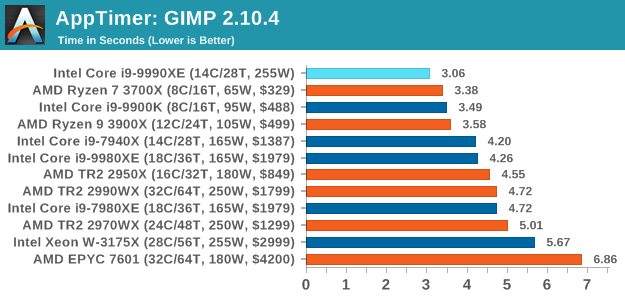
Application loading is a walk in the park for the Core i9-9990XE.
FCAT: Image Processing
The FCAT software was developed to help detect microstuttering, dropped frames, and run frames in graphics benchmarks when two accelerators were paired together to render a scene. Due to game engines and graphics drivers, not all GPU combinations performed ideally, which led to this software fixing colors to each rendered frame and dynamic raw recording of the data using a video capture device.
The FCAT software takes that recorded video, which in our case is 90 seconds of a 1440p run of Rise of the Tomb Raider, and processes that color data into frame time data so the system can plot an ‘observed’ frame rate, and correlate that to the power consumption of the accelerators. This test, by virtue of how quickly it was put together, is single threaded. We run the process and report the time to completion.
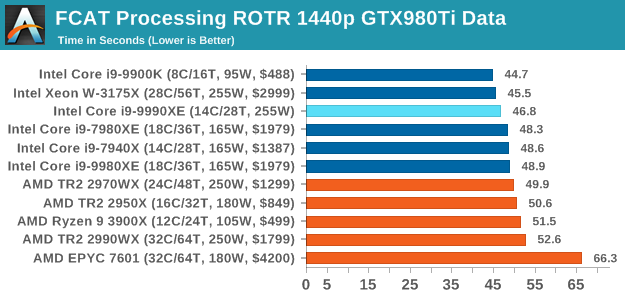
FCAT is getting fairly unified across all the processors, with only a few percent separating all the Intel parts.
3D Particle Movement v2.1: Brownian Motion
Our 3DPM test is a custom built benchmark designed to simulate six different particle movement algorithms of points in a 3D space. The algorithms were developed as part of my PhD., and while ultimately perform best on a GPU, provide a good idea on how instruction streams are interpreted by different microarchitectures.
A key part of the algorithms is the random number generation – we use relatively fast generation which ends up implementing dependency chains in the code. The upgrade over the naïve first version of this code solved for false sharing in the caches, a major bottleneck. We are also looking at AVX2 and AVX512 versions of this benchmark for future reviews.
For this test, we run a stock particle set over the six algorithms for 20 seconds apiece, with 10 second pauses, and report the total rate of particle movement, in millions of operations (movements) per second. We have a non-AVX version and an AVX version, with the latter implementing AVX512 and AVX2 where possible.
3DPM v2.1 can be downloaded from our server: 3DPMv2.1.rar (13.0 MB)
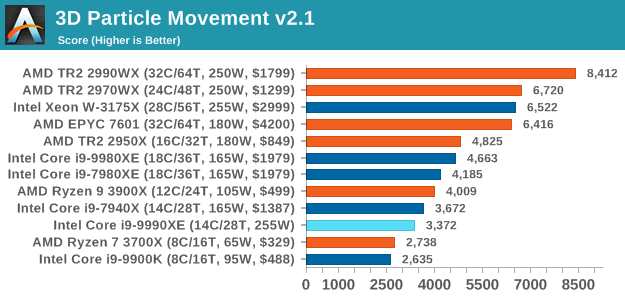
When we run our 3DPM test in a standard mode, the 9990XE again sees a slight regression compared to the 7940X, perhaps indicating that the mesh environment needs some extra MHz.
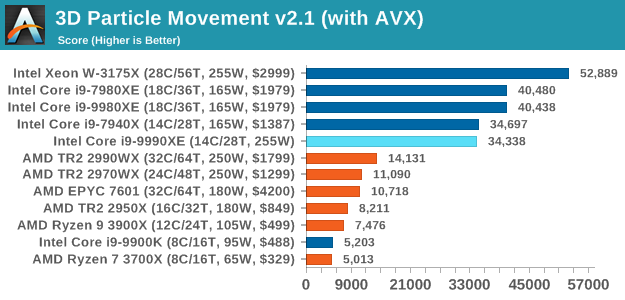
When adding AVX512 into the mix, the 9990XE rises up as with all the other Intel HEDT CPUs, but still can only match the slower 7940X despite having the same number of cores. At this point we're more core limited than frequency limited, indicating that there are some pipeline stalls in this test.
Dolphin 5.0: Console Emulation
One of the popular requested tests in our suite is to do with console emulation. Being able to pick up a game from an older system and run it as expected depends on the overhead of the emulator: it takes a significantly more powerful x86 system to be able to accurately emulate an older non-x86 console, especially if code for that console was made to abuse certain physical bugs in the hardware.
For our test, we use the popular Dolphin emulation software, and run a compute project through it to determine how close to a standard console system our processors can emulate. In this test, a Nintendo Wii would take around 1050 seconds.
The latest version of Dolphin can be downloaded from https://dolphin-emu.org/
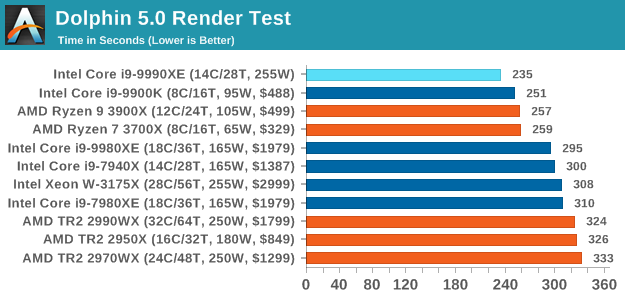
Dolphin is a heavily single threaded test, so we see the highest frequency from Intel and AMD at the top here.
DigiCortex 1.20: Sea Slug Brain Simulation
This benchmark was originally designed for simulation and visualization of neuron and synapse activity, as is commonly found in the brain. The software comes with a variety of benchmark modes, and we take the small benchmark which runs a 32k neuron / 1.8B synapse simulation, equivalent to a Sea Slug.

Example of a 2.1B neuron simulation
We report the results as the ability to simulate the data as a fraction of real-time, so anything above a ‘one’ is suitable for real-time work. Out of the two modes, a ‘non-firing’ mode which is DRAM heavy and a ‘firing’ mode which has CPU work, we choose the latter. Despite this, the benchmark is still affected by DRAM speed a fair amount.
DigiCortex can be downloaded from http://www.digicortex.net/
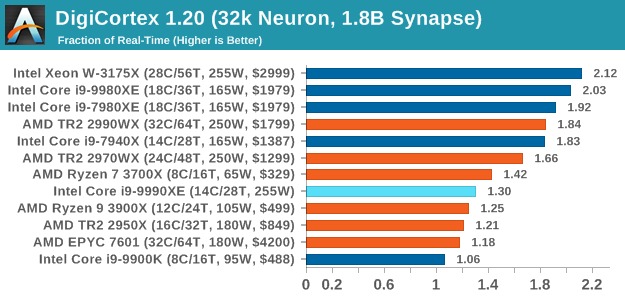
DigiCortex likes memory frequency and internal speeds more than raw core frequency, and again the 9990XE doesn't perform too well here.
y-Cruncher v0.7.6: Microarchitecture Optimized Compute
I’ve known about y-Cruncher for a while, as a tool to help compute various mathematical constants, but it wasn’t until I began talking with its developer, Alex Yee, a researcher from NWU and now software optimization developer, that I realized that he has optimized the software like crazy to get the best performance. Naturally, any simulation that can take 20+ days can benefit from a 1% performance increase! Alex started y-cruncher as a high-school project, but it is now at a state where Alex is keeping it up to date to take advantage of the latest instruction sets before they are even made available in hardware.
For our test we run y-cruncher v0.7.6 through all the different optimized variants of the binary, single threaded and multi-threaded, including the AVX-512 optimized binaries. The test is to calculate 250m digits of Pi, and we use the single threaded and multi-threaded versions of this test.
Users can download y-cruncher from Alex’s website: http://www.numberworld.org/y-cruncher/
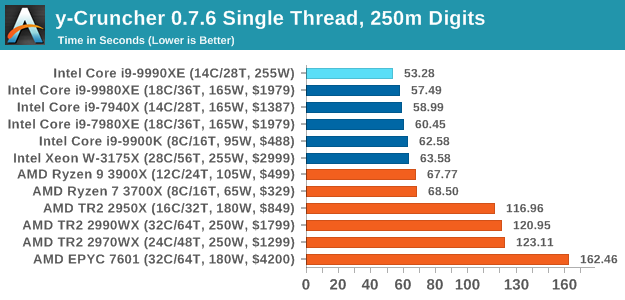
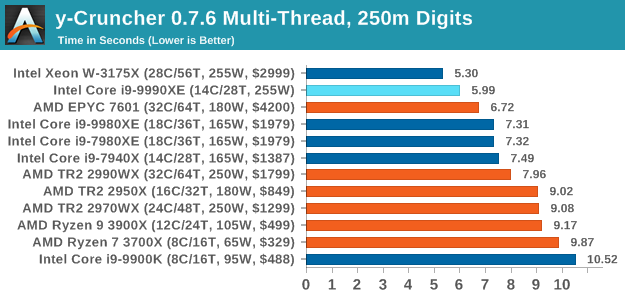
y-Cruncher is an AVX-512 accelerated test, and with the high frequency it gets the top score in our ST test.
Agisoft Photoscan 1.3.3: 2D Image to 3D Model Conversion
One of the ISVs that we have worked with for a number of years is Agisoft, who develop software called PhotoScan that transforms a number of 2D images into a 3D model. This is an important tool in model development and archiving, and relies on a number of single threaded and multi-threaded algorithms to go from one side of the computation to the other.
In our test, we take v1.3.3 of the software with a good sized data set of 84 x 18 megapixel photos and push it through a reasonably fast variant of the algorithms, but is still more stringent than our 2017 test. We report the total time to complete the process.
Agisoft’s Photoscan website can be found here: http://www.agisoft.com/
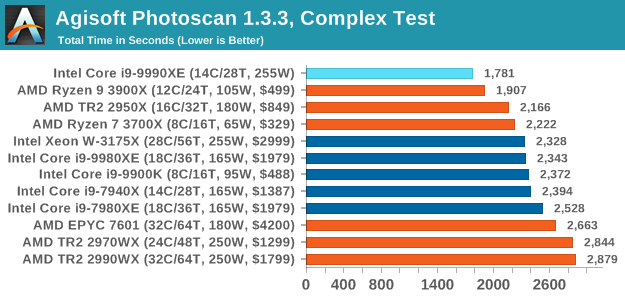
Agisoft is a variable threaded workload, and it seems the Core i9-9990XE has the best combination of cores and threads.



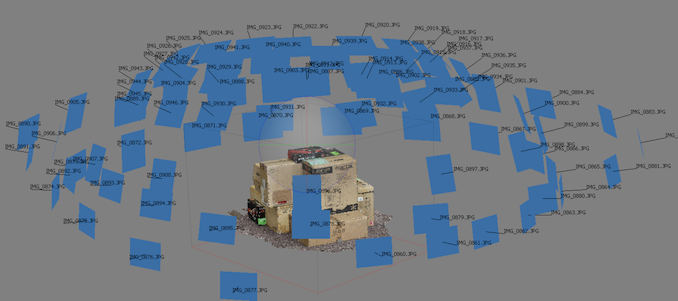








145 Comments
View All Comments
willis936 - Monday, October 28, 2019 - link
>but also pay experts and specialists to tune those systems for high latencyI believe this should read "low latency".
jospoortvliet - Tuesday, October 29, 2019 - link
Yup. And while correcting:> Against AMD counterparts, that 5.0 GHz frequency carves through anything like butter.
That is rather optimistic... the Intel is frequently bested by the 3700x and especially the 3900x - I would expect a 3950X might even win the majority of tests run here.
jospoortvliet - Tuesday, October 29, 2019 - link
I went ahead and did a quick count:* 3900X has 13 wins (7 more than 10%)
* 9990XE has 21 wins (10 more than 10%)
Now obviously the 9990XE is faster, but it better be with 2 more cores and 5 ghz and 400 watt power use and a price - well... ;-)
But it sure isn't the slam dunk it is described at - Ian writes like this monster wins in >90% of the tests, which it doesn't, not by a long shot. If it was readily available at $600 and had a TDP of 140W, I'd call it a winner, even if it doesn't *always* win. But if intel has to go THIS extreme and still loses in over 1/3rd of the graphs here at Anandtech, it is more a show of weakness if anything.
And all that while we await the 3950X and new gen Threadripper - it is good for Intel that they weren't out yet and part of the benchmark, otherwise the halo would be even harder to make out...
Netmsm - Tuesday, October 29, 2019 - link
Agree;I expected to read a completely impartial review, like always, but I feel some sort of inclination to bold strengths in a way that a true discussion of 9990xe's weaknesses is out of favor!
jgraham11 - Tuesday, October 29, 2019 - link
Agreed!Look at that amazing performance at 250W (which will probably run even hotter, just like the 9900k "stock (95W)" vs out of box settings(140W+)
Compared to the AMD 3900X at half the power(105W), that thing is a heater!
Same story as all the other recent articles about Intel chips:
Intel runs old games better, runs hotter, consumes more power, higher clock speed!
AMD runs new games better, runs cooler, consumes less power (in this case half at least), runs applications better
ballsystemlord - Wednesday, October 30, 2019 - link
I agree too. Ian was too excited when writing this review.I'm more concerned that we'll have to stare at this processor in the lineup from now on as each AMD TR3 processor is covered. That's totally unfair because this CPU is for auction only and in limited supply permanently.
Thus it'll look like Intel wins everything all the time. And then there are the people who will call this site a shill site because of that...
NikosD - Friday, November 1, 2019 - link
The whole article is another desperate move from Intel, just a few weeks before AMD releases Ryzen 3950X 16C/32T and new Threadripper 3rd gen.Unfortunately they found Anandtech and Dr. Ian Cutress again, to support their pathetic effort with some credibility.
And suddenly after publishing this kind of article, the problem moves from Intel's side to Anandtech's side.
My condolences.
peevee - Monday, October 28, 2019 - link
"This ultra-rare thing isn’t sold to consumers – Intel only sells it to select partners, and even then it is only sold via an auction, once per quarter, with no warranty from Intel."Pathetic strategy for bragging rights only...
fackamato - Monday, October 28, 2019 - link
I think you're in the wrong forums?Of course people will buy this if it brings value to them versus the price they have to pay.
bananaforscale - Thursday, October 31, 2019 - link
Sure, if value == bragging rights. Or if they have more money than sense.